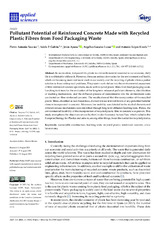Pollutant Potential of Reinforced Concrete Made with Recycled Plastic Fibres from Food Packaging Waste
Autor
Vaccaro, Pietro Antonio
Pérez Galvín, Adela
Ayuso Muñoz, Jesús
Lozano Lunar, Angélica
López Uceda, Antonio
Editor
MDPIFecha
2021Materia
Sustainable constructionLeaching tests
Recycled plastic
Reinforced concrete
Circular economy
METS:
Mostrar el registro METSPREMIS:
Mostrar el registro PREMISMetadatos
Mostrar el registro completo del ítemResumen
In our modern, fast-paced life, plastic is a versatile material essential to our economy; daily life is unthinkable without it. However, there are serious downsides for the environment and health, which are becoming more and more stark in our society, and the recycling of plastic offers a partial solution to these widespread problems. The present work delves into the environmental assessment of fibre-reinforced concrete specimens, made with recycled plastic fibres from food packaging waste. Leaching tank tests for the evaluation of the long-term release of pollutant elements, identification of leaching mechanisms, and the diffusion process of contaminants into the environment were conducted on fibre reinforced concrete. The results showed that the incorporation of the recycled plastic fibres, classified as non-hazardous, did not release relevant levels of any potential harmful element incorporated in concrete. Moreover, low mobility was detected in the studied elements and different release mechanisms were identified through long-term diffusion leaching tests. Hence, the environmental feasibility of the incorporation of recycled plastic fibre in concrete was proven. This study strengthens the objectives set out by the Circular Economy Action Plan, which includes the European Strategy for Plastics and aims to, among other things, boost the market for recycled plastics.

